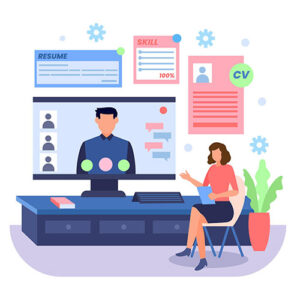The Benefits of Using Technology in HR
Table of Contents
ToggleIntroduction: The Evolution of HR Management
The world of human resources has undergone a significant transformation in recent years, driven by the rapid adoption of technology in various aspects of HR management. From AI-powered recruitment and selection to cloud-based performance management systems, the benefits of using technology in HR are numerous and far-reaching. In this article, we’ll explore how technology is revolutionizing HR, with a focus on the following key areas:
- Enhancing efficiency and reducing costs
- Improving employee experience and engagement
- Leveraging the power of AI and machine learning
Enhancing Efficiency and Reducing Costs with HR Technology
Automating Time-Consuming Tasks
One of the most significant benefits of using technology in HR is the automation of repetitive, time-consuming tasks. By implementing HR software and tools, organizations can streamline processes such as:
- Recruitment and applicant tracking: Tools like Credibled’s Automated Reference Checking can reduce the time and effort spent on manual reference checks, allowing HR professionals to focus on more strategic aspects of recruitment.
- Payroll and benefits administration: Cloud-based systems can automate payroll processing and benefits administration, minimizing the risk of errors and ensuring compliance with regulations.
- Time and attendance tracking: Digital solutions can efficiently manage employee schedules, leave requests, and attendance, reducing administrative workload for HR teams.
Improving Data Management and Analytics
Effective data management is crucial for making informed HR decisions. HR technology can help organizations collect, store, and analyze vast amounts of data, enabling them to:
- Monitor key HR metrics: Real-time dashboards and reporting tools can provide insights into essential HR metrics, such as turnover rate, time to hire, and employee engagement levels. Check out this list of hiring metrics you should be tracking.
- Identify trends and patterns: Advanced data analytics can help HR professionals spot trends and patterns in employee behavior, allowing them to address potential issues proactively.
- Enhance decision-making: By providing data-driven insights, HR technology can support more strategic decision-making and help organizations align their HR initiatives with overall business objectives.
Improving Employee Experience and Engagement through Technology
Facilitating Communication and Collaboration
Effective communication and collaboration are critical for driving employee engagement and satisfaction. HR technology can help organizations implement and monitor initiatives that foster a collaborative work environment, such as:
- Intranet platforms and social networks: Digital platforms can facilitate communication and collaboration among employees, enabling them to share knowledge and work together more effectively.
- Remote and flexible work arrangements: Cloud-based tools can support remote and flexible work arrangements, providing employees with the necessary resources to stay connected and productive from any location. Learn more about remote hiring strategies to stay ahead of the curve.

AI-powered algorithms can analyze vast amounts of data to identify top-tier candidates based on their skills, experiences, and other relevant factors.
Personalized Learning and Development Opportunities
Another crucial aspect of employee experience is the provision of personalized learning and development opportunities. HR technology can support these efforts by:
- Offering tailored learning paths: Digital learning platforms can analyze employee skills, preferences, and goals to create customized learning paths, providing employees with the resources they need to grow and develop within the organization.
- Tracking progress and measuring impact: HR technology can help organizations track employee progress, measure the impact of learning initiatives, and continuously refine their training programs to maximize effectiveness.
Leveraging the Power of AI and Machine Learning in HR
AI-Driven Recruitment and Selection
Artificial intelligence and machine learning have the potential to revolutionize the way organizations approach recruitment and selection. By leveraging AI-driven tools, HR professionals can:
- Enhance candidate sourcing: AI-powered algorithms can analyze vast amounts of data to identify top-tier candidates based on their skills, experiences, and other relevant factors. Learn more about finding top-tier candidates for your next hiring cycle.
- Reduce bias in the hiring process:AI-driven tools can minimize the impact of unconscious biases in the recruitment process by focusing on objective criteria rather than subjective opinions. Read more on minimizing interview bias in the hiring process.
- Improve candidate assessment: Machine learning algorithms can analyze candidate responses during interviews and assessments, providing more accurate insights into their suitability for the role.
Predictive Analytics and Workforce Planning
The use of predictive analytics in HR can help organizations make data-driven decisions about workforce planning and management. By leveraging AI and machine learning, HR professionals can:
- Forecast talent needs: Predictive models can analyze historical data to forecast future talent needs, enabling organizations to proactively address potential skills gaps. Discover ways to overcome skill shortages in the modern workplace.
- Identify flight risks: By analyzing various factors, AI-powered tools can help organizations identify employees who may be at risk of leaving, allowing HR teams to take preventive measures and retain top talent.
- Optimize workforce deployment: AI-driven insights can support strategic workforce planning, ensuring the right talent is deployed in the right roles at the right time.
Conclusion
Navigating the Future of HR Management with Technology
Credibled offers a range of HR technology solutions that can help organizations streamline their processes and improve their outcomes. To learn more about how Credibled can support your HR initiatives, visit www.credibled.com.
FAQs:
Technology can improve HR processes by increasing efficiency, reducing human error, and automating repetitive tasks. This allows HR professionals to focus on strategic initiatives, improve decision-making, and enhance employee engagement.




